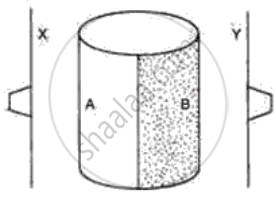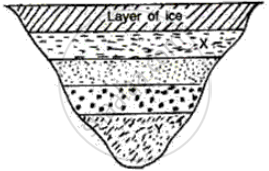Advertisements
Advertisements
Question
Consider the situation of the previous problem. Assume that the temperature of the water at the bottom of the lake remains constant at 4°C as the ice forms on the surface (the heat required to maintain the temperature of the bottom layer may come from the bed of the lake). The depth of the lake is 1.0 m. Show that the thickness of the ice formed attains a steady state maximum value. Find this value. The thermal conductivity of water = 0.50 W m−1°C−1. Take other relevant data from the previous problem.
Solution
Let the point upto which ice is formed is at a distance of x m from the top of the lake.
Under steady state, the rate of flow of heat from ice to this point should be equal to the rate flow of heat from water to this point.
Temperature of the top layer of ice = −10°C
Temperature of water at the bottom of the lake = 4°C
Temperature at the point upto which ice is formed = `((DeltaQ)/(Deltat))_{ice} = ((DeltaQ)/(Deltat))_{water}`
`k_{ice}/(x/(Axx10)`= `K_{water}/((1-x)/(Axx4)`
`(1.7 xx 10)/x = (0.5xx4)/(1-x)`
`(1.7)/x = (0.5xx4)/(1-x)`
17 - 17x = 2x
`⇒ x =17/19 = 0.89 m`
`⇒ x = 89 cm`
APPEARS IN
RELATED QUESTIONS
Give reason of Ice floats on water.
How does the anomalous expansion of water help aquatic organisms in cold climates?
Fill in the blank and rewrite the sentence.
The amount of water vapour in air is determined in terms of its ........... .
Answer the following:
On what basis and how will you determine whether air is saturated with vapour or not?
Water is cooled from 4 °C to 0 °C. It will :
A deep pond of water has its top layer frozen. What will be the likely temperature of water layer just in contact with ice?
A deep pond of water has its top layer frozen. What will be the likely temperature of water layer at the bottom of the pond?
What are land and sea breezes? Explain with the help of a labeled diagram.
The following diagrams illustrate three situations involving thermometers which are labeled A, Band C. In each situation the thermometers indicate different readings.
(i) What do you expect the approximate reading of the thermometer B and C would be? Give a reason for your answer.
(ii) How would the readings of A and B help you in calibrating a thermometer?

The following figure shows a metal cylinder, containing boiling water. One half side A is polished and another half, B is painted black. Two thin metal sheets X and Y are painted black and have one rubber stopper fixed with wax on each sheet. These sheets are equidistant from the boiling water (container A, B) as shown in the diagram. What would you expect to happen after a few minutes? Give a reason for your answer.

What will be the approximate temperature of water in the lake shown in the following diagram?

(i) At X, and
(ii) At Y?
When the temperature of water decreases below 4 °C it’s volume _______.
Match the columns:
| Column ‘A’ | Column ‘B’ |
| The density of water is maximum at | (a) 0°C |
| (b) 4°C | |
| (c) 100°C |
